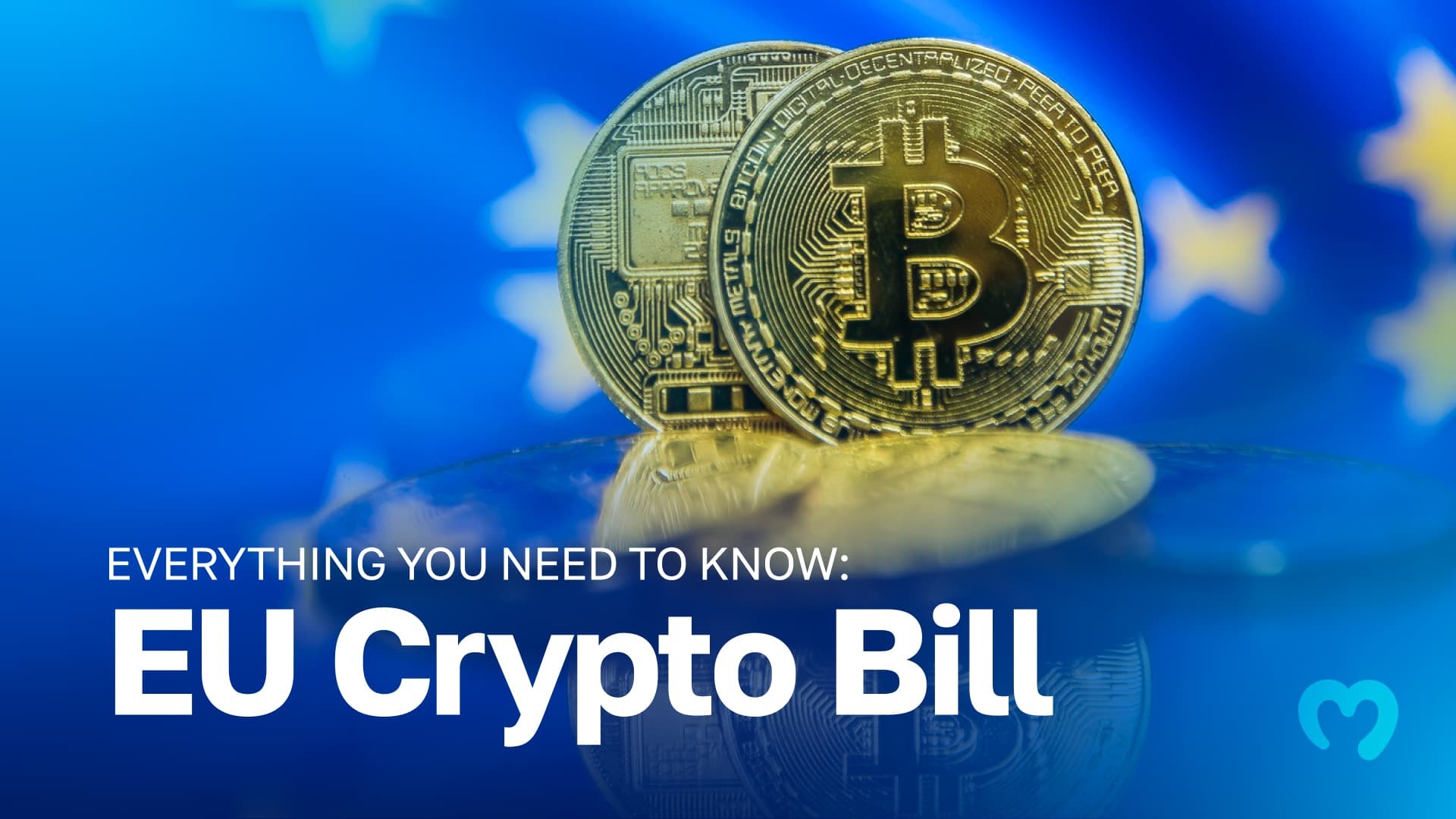The crypto world is often referred to as the “crypto wild west” by lawmakers worldwide. That’s because there aren’t any crypto regulations in many parts of the globe. The European Union recently passed its EU crypto bill of 2022, officially referred to as the MiCA (markets in crypto-assets) regulation. This legal bill aims to regulate most aspects of crypto-related operations in the EU. The European Parliament hopes to create a clear legal framework through which crypto users and service providers adhere to specific rules. Users must pay more attention to regulations when conducting transactions or using crypto exchanges. Also, users must abide by strict anti-money laundering rules when trading assets. For crypto service providers, this new bill brings numerous regulatory innovations in everyday business operations.
Furthermore, MiCa brings a whole new level of crypto regulations, hoping to protect users from scams and ensure companies play by the rules. However, this bill isn’t an all-encompassing set of regulations. It’s more of a general start when it comes to regulating the crypto market in the EU. The law aims to cover all the crypto market’s critical aspects.
This article will take a detailed look at the 2022 EU crypto bill. We’ll find out all the details of MiCa and how it regulates different sectors of the crypto market. Stay with us at Moralis Academy until the end of the article to learn everything you need to know about the new crypto regulations in the EU.

If you’re new to the world of crypto, Moralis Academy’s Blockchain and Bitcoin 101 course is a great starting point. You learn everything necessary in that course to get a solid foundation of what Bitcoin and blockchain technology are all about.
Crypto and Legal Regulations
Before diving into the EU crypto bill, we need to know what crypto regulations are. When the crypto market came into existence with the launch of Bitcoin (BTC) in 2009, there weren’t any laws regarding crypto. Furthermore, the concept of digital currency was new, and regulators were caught off guard during the initial years of crypto. The first regulations regarding crypto included digital currencies in the tax system. Regions such as the US and the EU treated crypto trading as taxable events, while crypto profits are considered capital gains. Many countries followed the example of the US and the EU by introducing their crypto tax regulations, but that was mostly it. Moreover, the US recently began paying considerable attention to crypto regulations, and the EU soon followed.
Current crypto laws aim to create a transparent legal framework for crypto users and service providers. Crypto enthusiasts, investors, crypto exchanges, and all businesses dealing with crypto must abide by a set of rules. The regulatory bodies make the rules in consultancy with the crypto industry representatives. It’s challenging to satisfy all segments of the crypto industry. Parts of the community will always be dissatisfied with the regulations. However, a good compromise can benefit most of the crypto industry.
In case you’re new to crypto, now is the perfect time to learn more about crypto terminology with the help of Moralis Academy. Our guide will help you understand the various terms used in this article.
Positive Aspects of Crypto Regulation
Due to the lack of regulations in the crypto market, users are often exposed to unclear crypto service policies across trading platforms and other crypto businesses. Users lack protection in unexpected events such as scams or hacks. It’s also unclear what types of services crypto businesses can offer users. For example, there were numerous cases of crypto platforms offering unrealistically high returns to clients and suddenly closing their operations. During 2022, several crypto meltdowns happened, such as the collapse of the Terra (LUNA) ecosystem and the TerraUSD (UST) stablecoin. The breakdown of Celsius Network and subsequent bankruptcy is another important event that showed how a lack of regulations leaves crypto users unprotected.
Legal protection in unfortunate events such as these is one of the most positive aspects of crypto regulations. Accordingly, if there aren’t any laws to protect users, the crypto market will remain a hazardous environment for them.
Furthermore, crypto regulations can create unified rules for all crypto businesses. Another layer of user protection is providing projects with a clear whitepaper, roadmap, and doxxed developers. These are some key reasons why the crypto market needs clear regulations.

Negative Aspects of Crypto Regulation
Crypto regulations also have harmful aspects that worry both users and crypto companies. Even though industry representatives have a say in planning crypto bills, the regulators pass the final verdict. These regulators can potentially pass laws that harm the essential aspects of crypto and blockchain technology. For example, regulators might decide to introduce bills that require crypto wallets to have a link to personal information about their owners. Such a move would be an attack on the foundations of crypto because digital currencies put a strong emphasis on privacy. That privacy is why crypto wallets don’t require user identification, unlike centralized crypto exchanges, which mostly require users to prove their identity.
Crypto regulations could also impose limitations on service providers that might hurt the whole community by banning certain services. If regulators would ban DeFi protocols from giving out crypto loans, they would effectively shut down a portion of the industry.
The same goes for liquidity pools, staking features, stablecoins, and digital marketplaces. These are some of the harmful aspects of crypto regulations that make the industry skeptical of crypto laws.

Check out Moralis Academy’s blockchain guides section to learn more about different aspects of blockchain technology.
The EU Crypto Bill
EU regulators recently passed the EU crypto bill, officially known as MiCA. European MEPs passed the bill with a 28:1 proportion in favor of the new law. Once the European Parliament approves the bill, it will become effective in 2024. Crypto companies will have more than a year to adapt their businesses to the new law. Crypto users will also have enough time to get acquainted with all the details of the law before it comes into effect.
That said, let’s dive deep into the particularities of MiCA and how it will affect the crypto market in the EU.
Impact of the EU Crypto Bill on Cryptocurrencies
One of the leading legal debates during 2022 is whether cryptocurrencies are securities or commodities. Generally, securities are financial assets for trading between interested parties, such as stocks and bonds. On the other hand, commodities are goods you can exchange for other goods, such as gold and oil.
MiCA introduces four particular categories of digital currencies to solve this issue. These categories include electronic money, utility tokens, tokens that refer to specific assets (such as company stocks), and crypto assets. It is still unclear which categories cryptocurrencies will fall into because there are so many different blockchains and crypto projects. However, all cryptocurrencies in the EU will fit into these categories. Users will know whether the crypto they are dealing with is a commodity or security and which tax laws apply to it. That said, it remains to see which categories will have security or commodity characteristics.
Impact of the EU Crypto Bill on DeFi
The DeFi sector is one of the critical segments of the crypto market, and it’s been rapidly growing during the last few years. However, there’s a lot of uncertainty regarding the services available on DeFi platforms. The EU crypto bill doesn’t mention the DeFi sector specifically. However, judging by the statements of EU officials, the law is setting a background for DeFi monitoring. Thanks to the law, regulators plan to introduce an initiative for monitoring the DeFi sector.
This DeFi monitoring project will be in the form of a tech solution capable of supervising DeFi protocols that operate in the EU. The project is still in its infancy, and we are yet to see how EU regulators will monitor the DeFi market. The central aspect of the solution will be automated data gathering from DeFi dapps (decentralized applications) on the Ethereum blockchain.
The DeFi market is essential to the crypto industry. However, the crypto market is currently going through rough times. Check our guide on how to invest during a crypto bear market to help you survive the crypto winter.
Impact of the EU Crypto Bill on Stablecoins
Stablecoins have a critical role in the crypto market because they are tied to the value of fiat currencies. Furthermore, leading stablecoins are tied to the US dollar, but there are also Euro-pegged projects. Moreover, the EU crypto bill gives special attention to stablecoins, mainly because of the “de-pegging” danger.
The case of TerraUSD’s (UST) algorithmic stablecoin meltdown caused great concern among EU regulators. The EU crypto bill states that stablecoin issuers must support minimal liquidity levels for issuing new stablecoin units. Furthermore, all stablecoin issuers will have to adhere to insolvency prevention protocols to avoid unfortunate events such as in the case of UST.

Impact on NFTs
The NFT market has gone through exponential growth during the last two years and, therefore, has gained lawmakers’ attention. However, the EU crypto bill doesn’t mention NFTs explicitly. The law might consider NFTs as financial products because of how they are traded and susceptible to market manipulations. EU regulators may introduce additional regulations regarding NFTs in the future.

The EU Crypto Bill and Environmental Impact
Due to EU laws regarding carbon emissions and environmental impact, the offered bill also considers energy consumption. Furthermore, cryptocurrency service providers must provide regulators with data about their energy consumption. Although, it’s still unclear how this will impact crypto miners and whether they will have to pay some fees or penalties. This aspect of the EU crypto bill mainly targets Bitcoin miners as the most prominent crypto energy consumers. The law effectively rejects the initiative to ban Bitcoin mining for good.

Setting up a Web3 dapp doesn’t need to be complicated. You can create your first decentralized application quickly and easily using a Moralis Web3 website template.
The EU Crypto Bill and Money Laundering
Money laundering is one of the main concerns of regulators when it comes to crypto. Unfortunately, malicious individuals have used crypto for money laundering in the past. Because of this, centralized crypto exchanges have long since been required to gather personal information from users. The EU crypto bill introduces anti-money laundering (AML) rules that the European Banking Authority (EBA) will enforce. EBA will also track all crypto businesses that don’t comply with the rules. Such companies might be subject to legal repercussions to prevent money laundering.
Impact of the EU Crypto Bill on Global Regulations
EU’s MiCA bill is a thorough attempt at regulating the crypto market in the European Union. However, it’s impossible to regulate the whole crypto industry with one bill, but it’s a good starting point. Many countries around the world still don’t have explicit regulations regarding crypto. That’s why the EU crypto bill might lead to adopting crypto laws in additional global regions.
The Crypto Industry’s Reaction to the EU Crypto Bill
The crypto industry’s reaction to the EU crypto bill is mixed. Part of the industry welcomes the regulations because there are finally explicit rules everyone must follow. However, many of the bill’s aspects are unclear and subject to individual interpretation. Additionally, EU member states might interpret the law differently, leading to further legal uncertainty. Fortunately, the bill didn’t introduce any infringing privacy regulations.
For more about crypto and what Web3 is, you should check out Moralis Academy’s Web3 ebooks.
EU Crypto Bill 2022: What is it About – Summary
The EU crypto bill is the most thorough attempt at regulating the crypto market in the EU so far. The bill introduces numerous clauses regarding cryptocurrency classification, stablecoins, environmental impact, and money laundering. Also, the law sets a regulatory framework for supervising the DeFi industry and NFTs.
However, we shouldn’t treat the EU crypto bill as the final regulatory step of the EU. It’s more of a “beginning” of the journey to incorporate the crypto industry into the existing financial system.

The Web3 revolution is here, and Web3 skills are becoming essential for developers. That’s why Moralis Academy has a practical guide on how to make a Web3 website.





